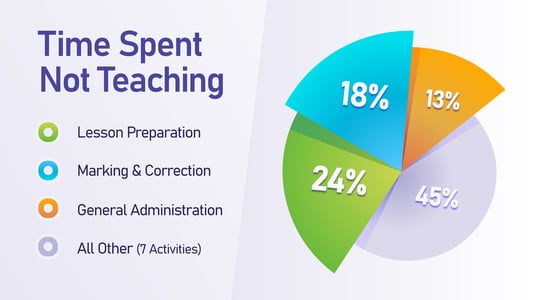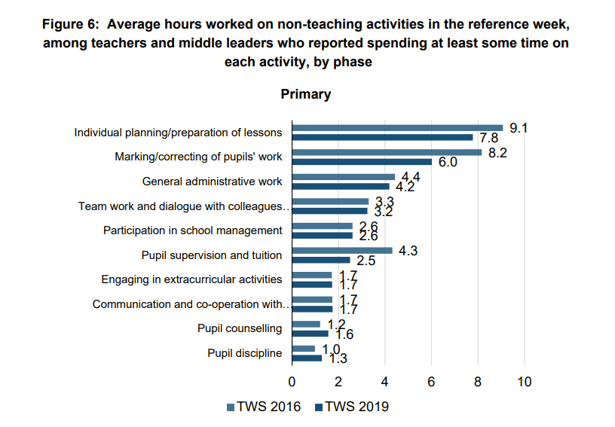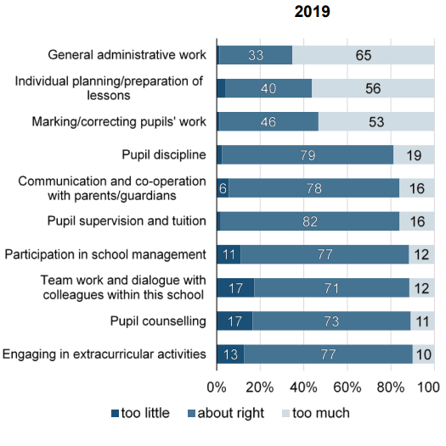Technology in education needs a clear set of guiding principles if teacher welfare is to be improved.
The integration of educational technology into classrooms was once heralded as transformative - a process that would revolutionize teaching and enhance teacher welfare. However, a closer examination reveals that the deployment of educational technology is not yet living up to its promise and, in some cases, may be exacerbating the challenges faced by teachers.
This article, part III of our series on the challenges of implementing digital education, makes the case that the current use of educational technology is not yet improving teacher welfare. We will also outline our perspective on how this can be changed.
Overburdened Workloads
Researchers from different countries have long reported high workloads and time pressure as among the main factors associated with stress in the teaching profession.
Educational technology was expected to change this by streamlining administrative tasks and providing more efficient teaching tools. However, the reality is often different, and the time savings teachers should have experienced have not yet materialized.
A study by the National Foundation for Educational Research (NFER) found that teachers in the UK spend a significant amount of time dealing with technical issues, adapting to new software, and troubleshooting problems.

Instead of reducing workloads, technology deployment, in some cases, adds a layer of complexity that can contribute to the stress experienced by teachers. Professor Sarah Younie, an education technology expert at De Montfort University in the UK, has expressed concern about this: "Rather than alleviating the workload, the implementation of technology has, in some instances, added extra layers of administrative tasks, impacting teacher well-being."
Rising Attrition Rates.
This may well be contributing to a climate of rising attrition. The European Agency for Safety and Health at Work has identified stress and burnout as major concerns within the teaching profession. One of their reports stated, "Teachers are experiencing burnout at an alarming rate due to excessive workloads and insufficient support systems."
Lack of Adequate Training.
The implementation of educational technology sometimes outpaces the training provided to teachers. The European Trade Union Committee for Education (ETUCE) has raised concerns about the insufficient support and training for educators in effectively utilizing technology in the classroom, with European Director Eva Héguy stating: "The rapid adoption of technology without proper training for teachers is a disservice to both educators and students. It contributes to feelings of inadequacy and adds to the existing challenges teachers face."

It is not simply a question of becoming familiar with a digital tool. Teachers are often expected to make a complex set of digital tools work together without adequate training. This can lead to frustration and impacting their confidence in using technology as an effective teaching aid.
The Need for Support.
When we consider the needs of teachers in the shift to digital education, we quickly come to the support teachers need. We argue that current implementations of digital technology in the classroom are driving four different types of support needs:
- Technological Literacy: Many educators face the hurdle of becoming proficient in new digital tools and platforms, and this technological literacy gap can impede the integration of digital resources into the teaching process.
- Pedagogical Shift: Shifting from traditional analogue teaching methods to digital pedagogy often requires a change in both mindset and instructional strategies. Without adequate support (especially a well-defined set of steps), teachers can struggle to adapt their teaching to maximize the benefits of digital tools.
- Resource Management: Too often, teachers grapple with the disparate array of digital resources available. Selecting, curating, and effectively integrating these resources into the curriculum can be time consuming and require guidance.
- IT Support: Even technically literate teachers will encounter technology issues that are beyond their expertise.
A Better Way.
We believe that success for teachers in digital education, on their terms, starts with the design principles of the software. If we do not design with teachers’ welfare in mind, we are unlikely to improve them. At ProScola, improving the working lives of teachers was our founding ambition. This has resulted in the formulation of three founding principles. We believe the consistent application of these principles is key to teachers enjoying success with educational technology.
Guiding Principles
Our guiding principles steer our approach:
- Prioritize the empowerment of educators (make teacher’s working lives better)
- Uphold the principle of digital assistance (digital works for teachers, not the other way around)
- By respecting the first two principles, we enable the promise of the digital classroom and create the conditions that enable innovation in both teaching and learning.
Embracing these principles lead us to the approach of ‘putting the lesson at the centre’ which has a profound impact when put into practice.
Principles in Action - Reduce Time Spent Not Teaching.
The first principle - prioritizing the empowerment of educators - might sound abstract and hard to achieve, but there is a very simple way to apply it. This is to reduce the time and energy expended not teaching.
Every teacher is all too familiar with the very large amount of time and energy spent on lesson preparation, marking/correction and general administration. Many of ProScola’s features are designed to allow teachers to streamline their work and focus more on getting back to what they love, which is teaching.
The Extent of Non-Teaching Activities
The graphic below shows what every teacher knows: that lesson planning/preparation and marking/correction of pupil’s work consume the most non-teaching time. The 2019 data shows these two activities take a very substantial 28% of non-teaching time.
 Source: Teacher workload survey 2019, UK National Foundation for Educational Research. You can download the full PDF report Statistics about teachers work.
Source: Teacher workload survey 2019, UK National Foundation for Educational Research. You can download the full PDF report Statistics about teachers work.
The same report showed that the majority of Primary School teachers reported that the amount of time spent on lesson planning/preparation (56%) and marking/correcting pupil’s work (53%) was ‘too much’.
 Source: Teacher workload survey 2019, UK National Foundation for Educational Research
Source: Teacher workload survey 2019, UK National Foundation for Educational Research
Upholding The Principle of Digital Assistance.
The second guiding principle is to uphold the principle of digital assistance. This ensures that the shift to digital actually works for teachers, and that there are no hidden penalties. Many digital solutions offer great potential outcomes but at a price teachers are unwilling to pay in terms of complexity and intrusiveness.
ProScola’s approach, which we describe as putting the lesson at the centre, uses a timeline that moves with both teachers and students. This enables teachers and students to go straight to a lesson and get on with the teaching and learning. It is an approach which, by design, minimizes the need for technological literacy, training, and digital resource management.
Our three-step implementation plan also enables schools to make a smooth transition from traditional teaching methods to digital instruction. This starts with an analogue class enhanced with digital materials, transitions through a digital led class where students work online through to full digital operation where all of the teacher’s daily work is conducted online.
Creating the Conditions for Development and Growth.
The third principle is that only by respecting the preceding two can we create the conditions that enable innovation in the classroom. By giving time back to the teacher without creating a new set of digital obstacles to overcome, teachers and students naturally start to find new and exciting possibilities.
Practice evolves and students are more engaged in a medium that is more natural to them. In his success story ProScola co-founder Dieter Reitz described the switch to digital as ‘natural, organic, and seamless’, and spoke of ‘being able to do things that were previously impossible’.
Conclusion:
While the potential benefits of educational technology in the classroom are clear, the current state of deployment raises questions about its current contribution to teacher welfare.
We believe that the integration of technology into education can only enhance the teaching profession if the shiny promise of digital resources (digital devices, learning tools and digital content) is balanced against three other dimensions [2]: Axiological principles (values and ethics), Pedagogical practices (methodologies) and Roles (such as teacher and students).
The inclusion of a clear set of well-defined principles helps we put the lesson, not the technology, at the centre, which is key to fulfilling the currently unfulfilled promise of Educational Technology.
[1] Kreuzfeld, S., Felsing, C. & Seibt, R. Teachers’ working time as a risk factor for their mental health - findings from a cross-sectional study at German upper-level secondary schools. BMC Public Health 22, 307 (2022).
[2] Pardo-Baldoví, San Martín-Alonso, Peirats-Chacón, 2023
About Proscola
We didn’t found ProScola to enable digital education. We were founded by teachers wishing to use technology to reduce the overwhelming workload and stress levels faced by teachers with the clear aim of allowing teachers to do more of what they love – which is teaching. However, to accomplish our aims it has become apparent that defining a path to success in digital education is essential and it has become part of our mission. If this article has inspired you, please contact Jason Thompson @jason.thompson@proscola.com